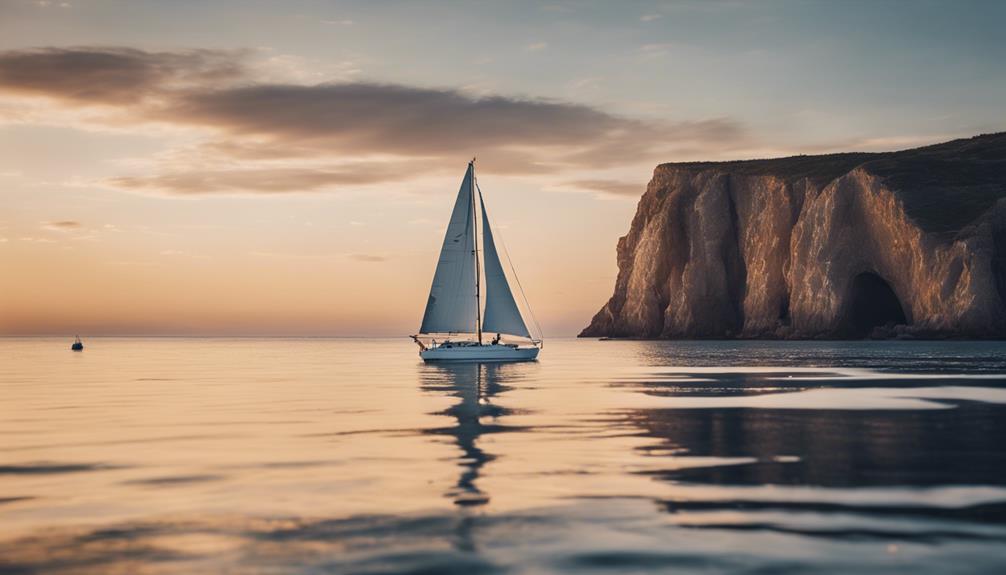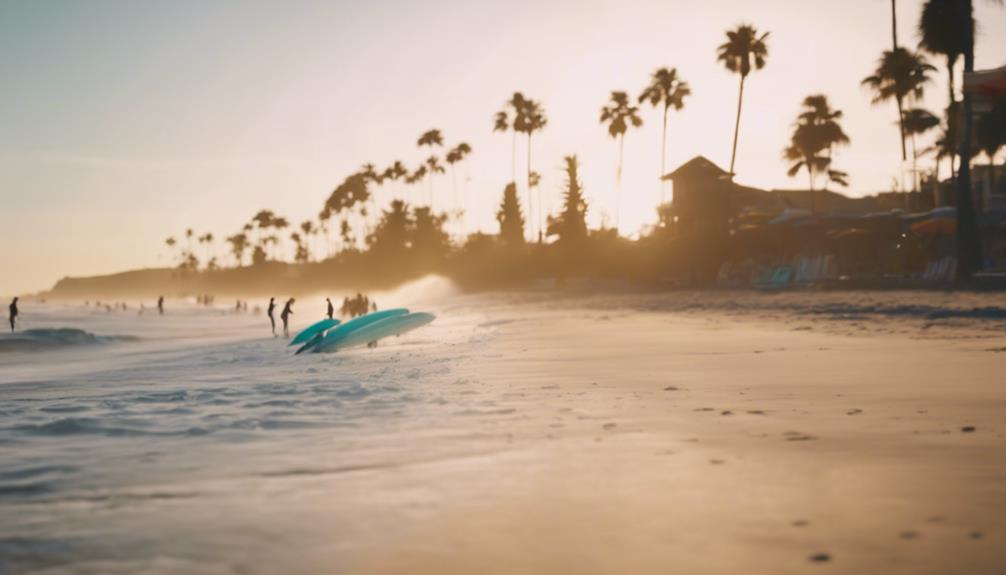The correct term for a boat that primarily uses sails for navigation is 'sailboat,' and yes, it's one word. This distinguishes it from the phrase 'sailing boat,' which can imply a broader category. Sailboats harness wind energy, featuring essential components like a hull, mast, and sails. They come in various styles, from small dinghies to large yachts, catering to different sailing experiences. Understanding this terminology helps clarify its unique aspects. If you want to explore more about the fascinating world of sailboats and their significance, there's plenty more to uncover!
Key Takeaways
- The correct term is "sailboat," written as one word, distinguishing it from "sailing boat."
- "Sailboat" refers specifically to boats primarily powered by sails.
- Using "sailboat" as one word is standard in nautical terminology.
- The term reflects a common understanding within the sailing community.
Definition of Sailboat
A sailboat's a type of boat that mainly uses sails to harness wind power for navigation. This vessel relies on the natural energy of the wind, making it distinct from motorized boats. The term 'sailboat' combines 'sail' and 'boat' into one word, reflecting its primary function. You'll find sailboats in various sizes and designs, ranging from small dinghies perfect for beginners to large yachts suited for experienced sailors.
When you think about a sailboat, picture its essential components: the hull, mast, rigging, and sails. Each part plays a vital role in ensuring the boat moves effectively across water. The hull provides buoyancy, while the mast supports the sails, allowing them to catch the wind. Rigging connects these components and helps control the sails' angle.
Sailboats are often used for recreation and racing, providing a thrilling experience for those who enjoy the open water. Whether you're starting on a leisurely cruise or competing in a regatta, understanding the definition of a sailboat enriches your appreciation of this unique vessel.
Characteristics of Sailboats
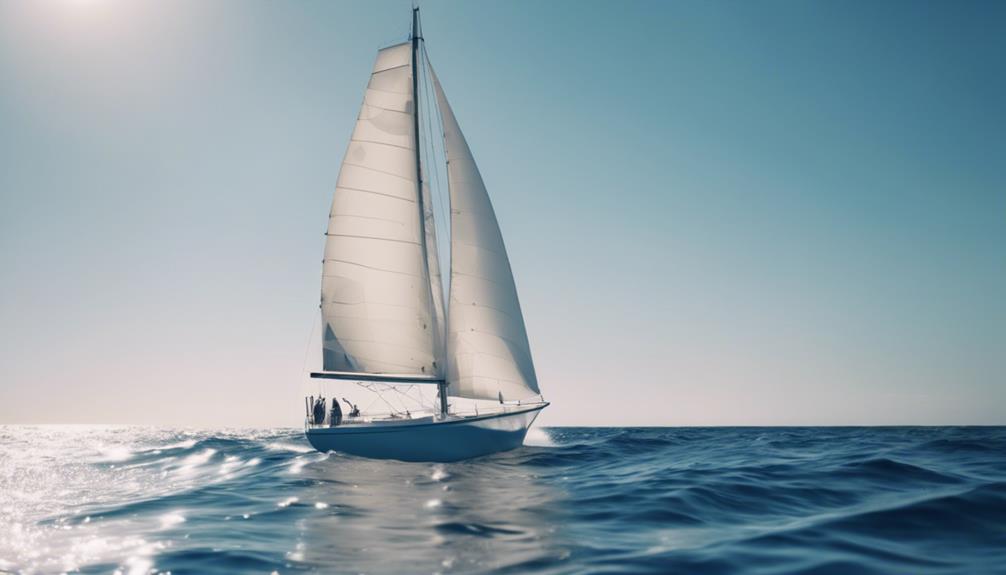
When you think about sailboats, consider their design and structure, which play an essential role in their performance.
You'll find various types and variations, each tailored for different sailing experiences, from racing to leisurely cruising.
Understanding how these elements work together can help you appreciate the stability and speed of these vessels.
Design and Structure
Sailboats feature a hull that provides buoyancy and stability, enabling efficient navigation through water.
The design of your sailboat typically includes one or more sails that harness wind energy, with mainsails and headsails like jibs being the most common types. These sails play a significant role in capturing the wind to propel you forward.
To enhance stability, sailboats often incorporate keels or centerboards. These structures help prevent capsizing and improve your ability to maneuver through various water conditions. When you're out on the water, you'll notice how these features work together to keep your sailboat balanced and responsive.
The rigging of a sailboat consists of ropes and cables that control the sails and mast. Adjusting this rigging is essential for adapting to changing wind conditions, allowing you to optimize your sailing experience.
Sailboats can vary widely in size, from small dinghies, typically around 12-15 feet long, to large yachts that exceed 50 feet. Each design serves different purposes, but the core features remain vital for efficient sailing. Understanding these characteristics can greatly enhance your enjoyment and skill while sailing.
Types and Variations
Understanding the different types and variations of sailboats enhances your appreciation for their unique characteristics and capabilities on the water. Sailboats come in various designs, each tailored for specific sailing experiences. Here's a quick overview of some popular types:
| Type | Description | Size Range |
|---|---|---|
| Monohull | Single hull, versatile for various conditions | 8 to 50+ feet |
| Catamaran | Two parallel hulls for increased stability | 18 to 60+ feet |
| Sloop | One mast with two sails, great for speed | 20 to 50+ feet |
| Ketch | Two masts, larger main sail, and smaller mizzen sail | 25 to 60+ feet |
Additionally, sailboats vary in materials like fiberglass, wood, and aluminum, each impacting durability and performance. Features like keels and centerboards play essential roles in enhancing stability and maneuverability, allowing you to sail confidently in varying wind conditions. By understanding these types and variations, you can make better choices based on your sailing preferences and needs.
Performance and Stability
The performance and stability of a sailboat hinge on key design elements like hull shape, sail configuration, and the strategic placement of keels or centerboards. A well-designed hull shape greatly affects your sailboat's performance, impacting speed and maneuverability. When you're out on the water, the way your sailboat glides through waves can make all the difference.
Sail design is equally vital; the size and shape of the sails determine how effectively your boat harnesses wind energy for propulsion. You'll find that a balanced center of gravity and center of lateral resistance is essential for maintaining stability during navigation, preventing capsizing in challenging conditions.
Modern sailboats often incorporate advanced materials that enhance performance and durability. These innovations allow for better handling and resilience, no matter the sailing environment.
Types of Sailboats

When exploring types of sailboats, you'll find a variety of designs that cater to different sailing styles and preferences.
One of the most common types is the monohull, featuring a single hull, perfect for cruising and racing. If you prefer more stability, catamarans with their two-hull design might be more your speed.
Another popular choice is the sloop, which has a single mast and two sails: a fore sail and a main sail. Ketches offer versatility with their two masts, allowing for more sail area and easier handling in various conditions. If you're looking for something similar to a sloop but with a twist, consider a cutter; it boasts a larger headsail, making it effective in changing winds.
For those drawn to speed, racing sailboats like dinghies are designed to be small and lightweight, providing agility on the water.
Each type of sailboat has unique features tailored to specific sailing experiences, so think about your preferences and needs as you choose the right one for your adventures.
Navigation and Operation
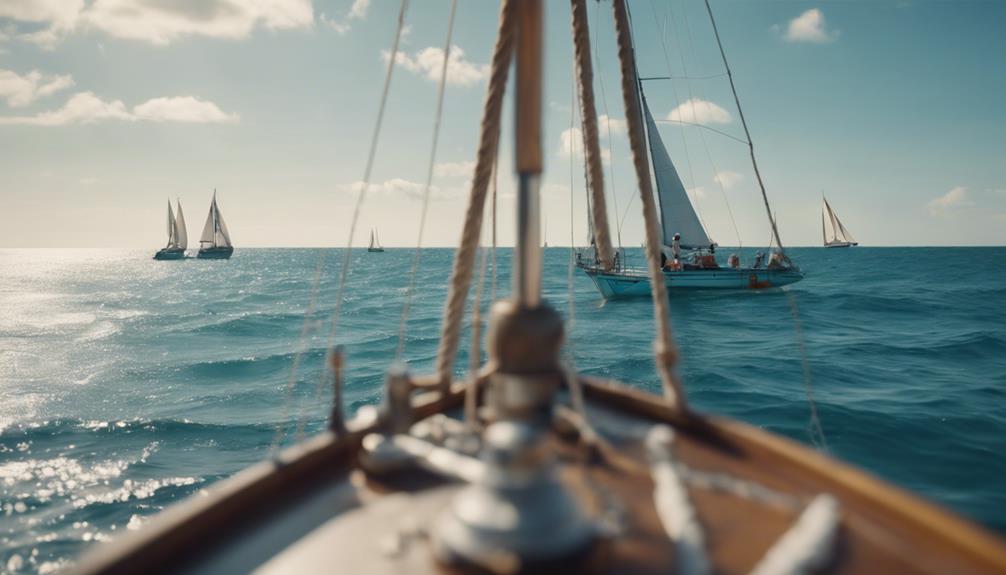
Steering a sailboat requires a keen awareness of wind patterns and the ability to execute essential maneuvers like tacking and jibing. Mastery of these techniques is vital for effective navigation, allowing you to harness the wind and steer your vessel with confidence.
| Maneuver | Description |
|---|---|
| Tacking | Turning the bow of the sailboat through the wind. |
| Jibing | Turning the stern of the sailboat through the wind. |
| Points of Sail | Different angles relative to the wind direction. |
| Weather Monitoring | Continuously checking wind speed and direction. |
Understanding sailing terminology, such as points of sail, enhances your ability to communicate and execute maneuvers while on the water. As you navigate, keep a close eye on weather conditions; changes in wind speed and direction can dramatically affect your sailboat's performance. By staying alert and informed, you can guarantee a safer and more enjoyable sailing experience. Embrace these skills, and you'll find yourself mastering the art of sailing!
Historical Context

Sailboats have played an essential role in human history, serving as important vessels for trade, exploration, and naval warfare across ancient and modern cultures. You might be surprised to learn that sailboats have been utilized for thousands of years, with evidence tracing back to ancient civilizations like the Egyptians and Mesopotamians. These early sailors relied on simple wooden vessels for their journeys.
During the Age of Sail, from the 16th to the 19th centuries, the design and construction of sailboats evolved dramatically. This period marked a peak in their usage, particularly in naval warfare and commerce. Innovations in sail designs, such as the lateen and square sails, transformed navigation and improved sailing efficiency.
Today, modern sailboats incorporate advanced materials like fiberglass, enhancing performance and durability compared to their ancient counterparts. Even now, sailboats remain integral to maritime culture, with their historical significance showcased in various sailing competitions and traditions that continue to thrive.
Understanding the evolution of sailboats helps you appreciate their enduring impact on human history and maritime endeavors.
Environmental Impact
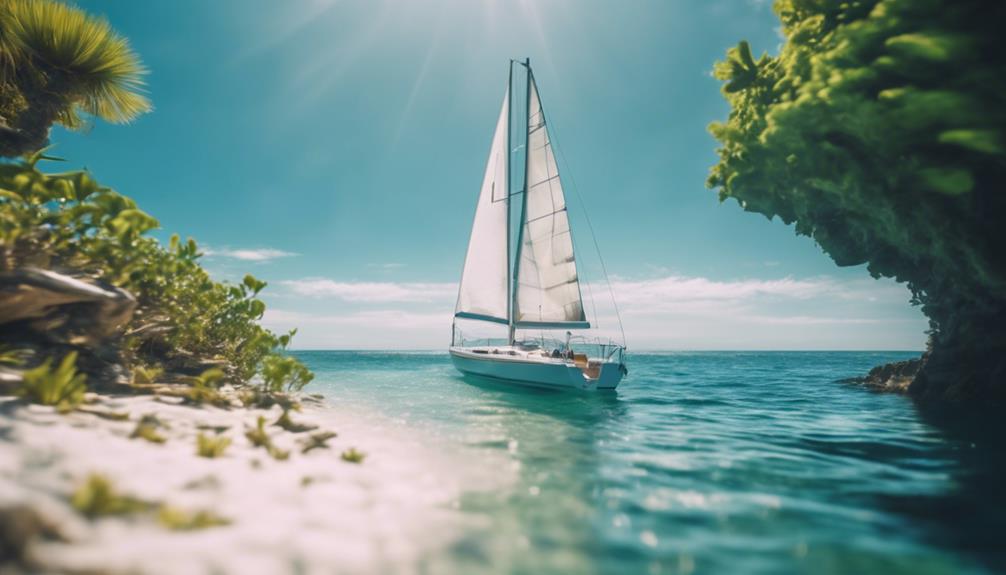
As you explore the world of sailing, you'll find that these vessels offer a remarkably eco-friendly way to navigate the waters, producing no direct emissions during operation. By harnessing wind energy for propulsion, a sailboat appreciably reduces reliance on fossil fuels compared to traditional motorboats. This makes sailing an appealing choice for environmentally-conscious individuals.
Environmental advocates stress that responsible sailing practices play an essential role in preserving marine ecosystems and promoting ocean conservation. When you sail, you're likely to witness firsthand the impacts of pollution and overfishing, which can deepen your understanding of these issues. A sailboat encourages a connection to the ocean that many other activities don't.
Moreover, the sailing community is increasingly adopting sustainable practices, such as minimizing waste and using eco-friendly materials. By choosing a sailboat, you're not just enjoying the sport; you're also participating in a movement that seeks to protect marine environments.
Every time you set sail, you're contributing to a greener future, making a positive impact on the waters you traverse. Embrace the eco-friendly benefits of sailing and become an advocate for the oceans you love.
Common Misconceptions
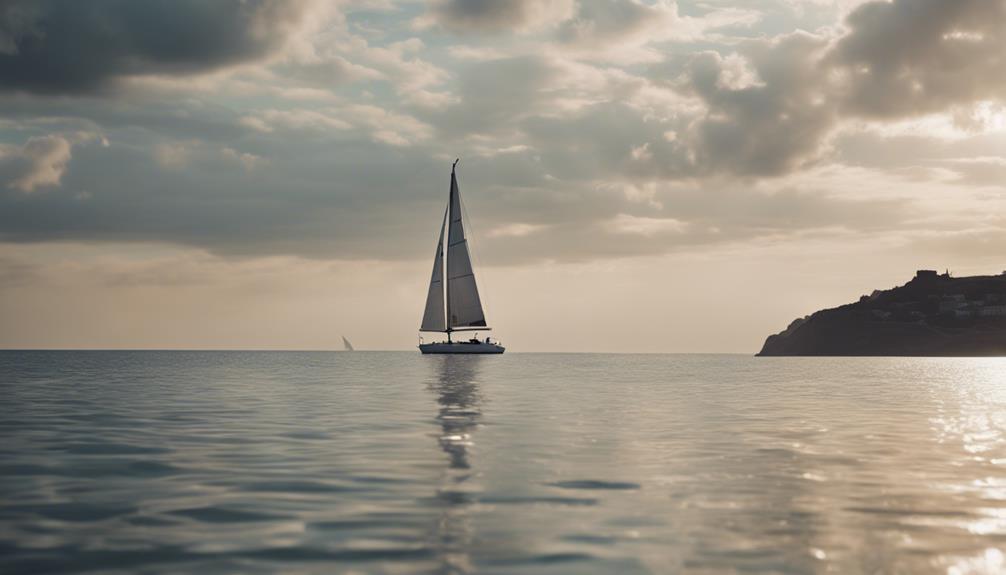
Many people get mixed up about sailboats, often assuming they're all large vessels or equipped with multiple sails, when in fact, they can vary considerably in size and design. Understanding the misconceptions surrounding sailboats can help you appreciate their diversity.
Here's a quick breakdown:
| Misconception | Reality | Example |
|---|---|---|
| All sailboats are large vessels | Sailboats can be small, like dinghies | Dinghy (1 sail) |
| All sailboats have multiple sails | Many have just one sail | Catboat (1 sail) |
| Sailboats can't operate alone | Autonomous sailboats exist | Robotic sailboat |
| All sailboats are slow | Speed varies based on design and size | Racing sailboat |
| Sailing boat is the same as sailboat | ‘Sailboat' is one word, distinct in meaning | Sailboat vs. sailing boat |
Frequently Asked Questions
Is Sail Boat One Word or Two?
You might wonder if "sail boat" is one word or two. It's actually one word: "sailboat." This term correctly describes a boat propelled by sails, important for clear communication in sailing contexts.
Is Sailboat a Compound Word?
You might wonder about the structure of certain words. In this case, 'sailboat' is indeed a compound word. It combines 'sail' and 'boat,' creating a specific term for a vessel designed for sailing.
What's Another Word for a Sailboat?
If you're looking for another word for a sailboat, you might consider terms like “yacht” for larger vessels or “dinghy” for smaller ones. Each term highlights different types of sailing crafts you may encounter.
What Is the Plural of Sailboat?
When you're steering through the waters of language, remember this: the plural of sailboat is sailboats. Just like a fleet gliding through waves, it captures the essence of multiple vessels sailing together in harmony.
What is the Correct Terminology for a Boat with Sails?
When it comes to understanding sail boat terminology, the correct term for a boat with sails is a sailboat or sailing vessel. This type of boat uses the wind to propel itself through the water, making it a popular choice for recreational and competitive sailing activities.
Conclusion
So, whether you're gliding across shimmering waters or dreaming of the open sea, understanding sailboats enriches your journey.
These graceful vessels, like whispers of the wind, invite you to explore the horizon.
Remember, it's one word—sailboat—unifying the spirit of adventure and the artistry of sailing.
Embrace the waves, feel the breeze, and let the sails carry you to new discoveries.
The world awaits, and every sailboat holds a story just waiting to unfurl.

